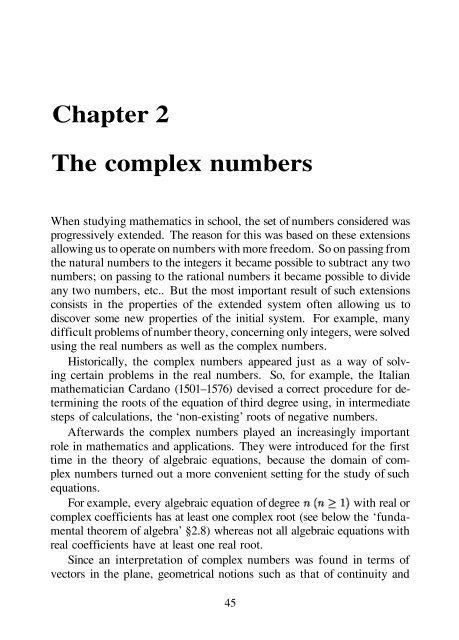Abel's theorem in problems and solutions - School of Mathematics
Abel's theorem in problems and solutions - School of Mathematics
Abel's theorem in problems and solutions - School of Mathematics
Create successful ePaper yourself
Turn your PDF publications into a flip-book with our unique Google optimized e-Paper software.
Chapter 2<br />
The complex numbers<br />
When study<strong>in</strong>g mathematics <strong>in</strong> school, the set <strong>of</strong> numbers considered was<br />
progressively extended. The reason for this was based on these extensions<br />
allow<strong>in</strong>g us to operate on numbers with more freedom. So on pass<strong>in</strong>g from<br />
the natural numbers to the <strong>in</strong>tegers it became possible to subtract any two<br />
numbers; on pass<strong>in</strong>g to the rational numbers it became possible to divide<br />
any two numbers, etc.. But the most important result <strong>of</strong> such extensions<br />
consists <strong>in</strong> the properties <strong>of</strong> the extended system <strong>of</strong>ten allow<strong>in</strong>g us to<br />
discover some new properties <strong>of</strong> the <strong>in</strong>itial system. For example, many<br />
difficult <strong>problems</strong> <strong>of</strong> number theory, concern<strong>in</strong>g only <strong>in</strong>tegers, were solved<br />
us<strong>in</strong>g the real numbers as well as the complex numbers.<br />
Historically, the complex numbers appeared just as a way <strong>of</strong> solv<strong>in</strong>g<br />
certa<strong>in</strong> <strong>problems</strong> <strong>in</strong> the real numbers. So, for example, the Italian<br />
mathematician Cardano (1501–1576) devised a correct procedure for determ<strong>in</strong><strong>in</strong>g<br />
the roots <strong>of</strong> the equation <strong>of</strong> third degree us<strong>in</strong>g, <strong>in</strong> <strong>in</strong>termediate<br />
steps <strong>of</strong> calculations, the ‘non-exist<strong>in</strong>g’ roots <strong>of</strong> negative numbers.<br />
Afterwards the complex numbers played an <strong>in</strong>creas<strong>in</strong>gly important<br />
role <strong>in</strong> mathematics <strong>and</strong> applications. They were <strong>in</strong>troduced for the first<br />
time <strong>in</strong> the theory <strong>of</strong> algebraic equations, because the doma<strong>in</strong> <strong>of</strong> complex<br />
numbers turned out a more convenient sett<strong>in</strong>g for the study <strong>of</strong> such<br />
equations.<br />
For example, every algebraic equation <strong>of</strong> degree with real or<br />
complex coefficients has at least one complex root (see below the ‘fundamental<br />
<strong>theorem</strong> <strong>of</strong> algebra’ §2.8) whereas not all algebraic equations with<br />
real coefficients have at least one real root.<br />
S<strong>in</strong>ce an <strong>in</strong>terpretation <strong>of</strong> complex numbers was found <strong>in</strong> terms <strong>of</strong><br />
vectors <strong>in</strong> the plane, geometrical notions such as that <strong>of</strong> cont<strong>in</strong>uity <strong>and</strong><br />
45

















